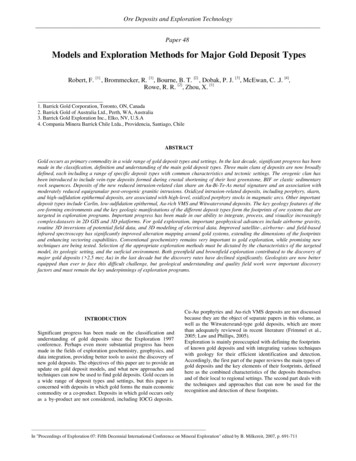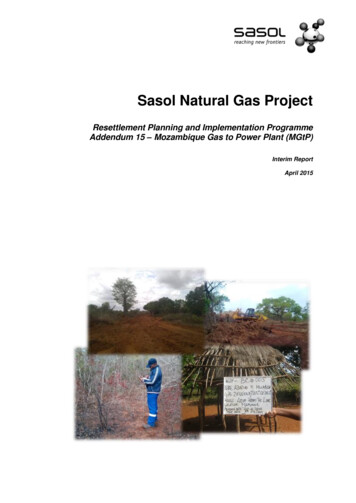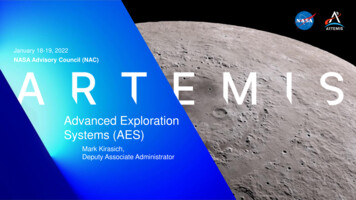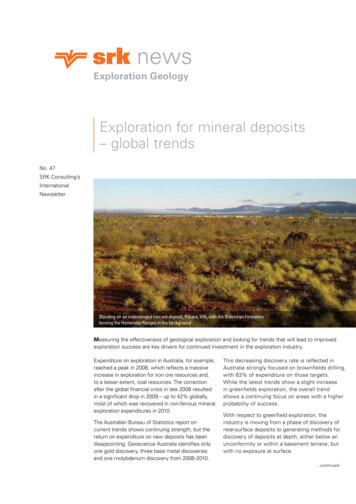
Transcription
Ore Deposits and Exploration TechnologyPaper 48Models and Exploration Methods for Major Gold Deposit TypesRobert, F. [1] , Brommecker, R. [1], Bourne, B. T. [2] , Dobak, P. J. [3], McEwan, C. .J. [4],Rowe, R. R. [2], Zhou, X. [1]1. Barrick Gold Corporation, Toronto, ON, Canada2. Barrick Gold of Australia Ltd., Perth, WA, Australia3. Barrick Gold Exploration Inc., Elko, NV, U.S.A4. Compania Minera Barrick Chile Ltda., Providencia, Santiago, ChileABSTRACTGold occurs as primary commodity in a wide range of gold deposit types and settings. In the last decade, significant progress has beenmade in the classification, definition and understanding of the main gold deposit types. Three main clans of deposits are now broadlydefined, each including a range of specific deposit types with common characteristics and tectonic settings. The orogenic clan hasbeen introduced to include vein-type deposits formed during crustal shortening of their host greenstone, BIF or clastic sedimentaryrock sequences. Deposits of the new reduced intrusion-related clan share an Au-Bi-Te-As metal signature and an association withmoderately reduced equigranular post-orogenic granitic intrusions. Oxidized intrusion-related deposits, including porphyry, skarn,and high-sulfidation epithermal deposits, are associated with high-level, oxidized porphyry stocks in magmatic arcs. Other importantdeposit types include Carlin, low-sulfidation epithermal, Au-rich VMS and Witwatersrand deposits. The key geology features of theore-forming environments and the key geologic manifestations of the different deposit types form the footprints of ore systems that aretargeted in exploration programs. Important progress has been made in our ability to integrate, process, and visualize increasinglycomplex datasets in 2D GIS and 3D platforms. For gold exploration, important geophysical advances include airborne gravity,routine 3D inversions of potential field data, and 3D modeling of electrical data. Improved satellite-, airborne- and field-basedinfrared spectroscopy has significantly improved alteration mapping around gold systems, extending the dimensions of the footprintsand enhancing vectoring capabilities. Conventional geochemistry remains very important to gold exploration, while promising newtechniques are being tested. Selection of the appropriate exploration methods must be dictated by the characteristics of the targetedmodel, its geologic setting, and the surficial environment. Both greenfield and brownfield exploration contributed to the discovery ofmajor gold deposits ( 2.5 moz Au) in the last decade but the discovery rates have declined significantly. Geologists are now betterequipped than ever to face this difficult challenge, but geological understanding and quality field work were important discoveryfactors and must remain the key underpinnings of exploration programs.INTRODUCTIONSignificant progress has been made on the classification andunderstanding of gold deposits since the Exploration 1997conference. Perhaps even more substantial progress has beenmade in the fields of exploration geochemistry, geophysics, anddata integration, providing better tools to assist the discovery ofnew gold deposits. The objectives of this paper are to provide anupdate on gold deposit models, and what new approaches andtechniques can now be used to find gold deposits. Gold occurs ina wide range of deposit types and settings, but this paper isconcerned with deposits in which gold forms the main economiccommodity or a co-product. Deposits in which gold occurs onlyas a by-product are not considered, including IOCG deposits.Cu-Au porphyries and Au-rich VMS deposits are not discussedbecause they are the object of separate papers in this volume, aswell as the Witwatersrand-type gold deposits, which are morethan adequately reviewed in recent literature (Frimmel et al.,2005; Law and Phillips, 2005).Exploration is mainly preoccupied with defining the footprintsof known gold deposits and with integrating various techniqueswith geology for their efficient identification and detection.Accordingly, the first part of the paper reviews the main types ofgold deposits and the key elements of their footprints, definedhere as the combined characteristics of the deposits themselvesand of their local to regional settings. The second part deals withthe techniques and approaches that can now be used for therecognition and detection of these footprints.In "Proceedings of Exploration 07: Fifth Decennial International Conference on Mineral Exploration" edited by B. Milkereit, 2007, p. 691-711
692Plenary Session: Ore Deposits and Exploration TechnologyOVERVIEW OF GOLD SYSTEMSMuch has been published on gold deposits in the last decade,leading to (1) significant improvement in the understanding ofsome models, (2) the definition of new types or sub-types ofdeposits, and (3) the introduction of new terms. However,significant uncertainty remains regarding the specific distinctionbetween some types of deposits. Consequently, specific giantdeposits are ascribed to different deposit types by differentauthors. In this paper, we have adopted the most acceptednomenclature and models used in important reviews publishedin the last decade (e.g. Hagemann and Brown, 2000; Sillitoe andHedenquist, 2003).As represented in Figure 1 and compiled in Table 1, thirteenglobally significant types of gold deposits are presentlyrecognized, each with its own well-defined characteristics andenvironments of formation. Minor types of gold deposits are notdiscussed in this paper. As proposed by Robert et al. (1997) andPoulsen et al. (2000), many of these gold deposit types can begrouped into clans, i.e. families of deposits that either formed byrelated processes or that are distinct products of large scalehydrothermal systems. These clans effectively correspond to themain classes of gold models, such as the orogenic, reducedintrusion-related, and oxidized intrusion-r e l a t e d o n e s(Hagemann and Brown, 2000). Deposit types such as Carlin,Au-rich VMS, and low-sulfidation are viewed by differentauthors either as stand-alone models or as members of thebroader oxidized intrusion-related clan. They are treated here asstand-alone deposit types, whereas high- and intermediatesulfidation and alkalic epithermal deposits are considered as partof the oxidized intrusion-related clan. Witwatersrand depositsare still controversial and viewed either as modified paleoplaceror as orogenic deposits.Figure 1: Schematic cross section showing the key geologic elements of the main gold systems and their crustal depths of emplacement. Note thelogarithmic depth scale. Modified from Poulsen et al. (2000), and Robert (2004a).
Robert, F., et al.Models and Exploration methods for Major Gold Deposit Types693Main deposit types and clansThe term orogenic has been originally introduced by Groves etal. (1998) in recognition of the fact that quartz-carbonate veingold deposits in greenstone and slate belts, including those inBIF, have similar characteristics and have formed by similarprocesses. Originally, the orogenic model applied strictly to syntectonic vein-type deposits formed at mid-crustal levels incompressional or transpressional settings, i.e. syn-orogenicdeposits. However, the term has been progressively broadenedto include deposits that are post-orogenic relative to processes attheir crustal depth of formation. This has led to significantambiguity in the definition of the boundary between theorogenic and reduced intrusion-related deposit models, withmany type examples being ascribed to one model or the other byvarious authors (Thompson and Newberry, 2000; Goldfarb et al.,2001). In this paper, as illustrated in Figure 1, the orogenic clanis defined to only include the syn-tectonic quartz-carbonatevein-type deposits and their equivalents, formed at mid-crustallevels. Specific deposit types in this clan include the turbiditehosted and greenstone-hosted vein deposits, as well as the BIFhosted veins and sulfidic replacement deposits (Figure 1; Table1). As discussed in more detail below, a confusing issue is thatgreenstone belts also contain gold deposit types that don’t fit theorogenic model as defined here (Groves et al., 2003; Robert etal., 2005). There is no consensus on the origin of these atypicaldeposits.The reduced intrusion-related model (RIR) has been betterdefined in the last decade (cf. Lang et al., 2000). Deposits of thisclan are distinguished by a Au-Bi-Te-As metal association and aclose spatial and temporal association with moderately-reducedequigranular granitic intrusions (Table 1; Thompson andNewberry, 2000). These deposits occur mainly in reducedsiliciclasic sedimentary rock sequences and are commonlyorogenic deposits. A range of styles and depths of formation hasbeen documented for RIR deposits, including intrusion-hosteddeposits of mesozonal to epizonal character, and more distal,sediment-hosted mesozonal equivalents (Figure 1, Table 1).Deposits of the sediment-hosted type correspond to the initialsediment-hosted stockwork-disseminated type of Robert et al.(1997), as well as to the pluton-related thermal aureole gold(TAG) deposits of Wall (2000) and Wall et al. (2004). Severaldeposits of the sediment-hosted IR deposits have also beenascribed to the orogenic clan by Goldfarb et al. (2005).The oxidized intrusion-related clan (OIR) includes the wellknown porphyry and high-sulfidation epithermal gold deposittypes, as well as skarn and manto type deposits, formed incontinental and oceanic convergent plate settings. Thesedeposits are best regarded as components of large hydrothermalsystems centered on high-level, generally oxidized, intermediateto felsic porphyry stocks (Figure 1; Table 1). In the last decade,the genetic connection between porphyry and high-sulfidationepithermal deposits has been more firmly established (Heinrichet al., 2004), and it has been suggested that the largest depositsof this clan form in compressional arcs (Sillitoe and Hedenquist,2003). The characteristics and settings of the alkalic endmember of porphyry deposits have also been refined, as has theirpossible connection with low-sulfidation alkalic epithermalsystems (Jensen and Barton, 2000).Other types of globally important gold deposit include lowand intermediate-sulfidation epithermal, Carlin, Au-rich VMS,and Witwatersrand type deposits (Figure 1). Epithermal depositsare now subdivided into low-, intermediate- and high-sulfidationcategories on the basis of mineralization and alterationassemblages (Sillitoe and Hedenquist, 2003). Intermediatesulfidation deposits, like high-sulfidation ones, are interpreted tobe a component of large OIR systems, as is the case for theVictoria veins in the Far Southeast-Lepanto system and atKelian. These deposits were initially singled out as carbonatebase-metal Au deposit type by Corbett and Leach (1998), andare characterized by a pyrite, low-Fe sphalerite and Mncarbonate ore assemblages accompanied by dominant illitealteration. Mineralization can consist of veins and breccia bodiesand commonly display a larger vertical continuity than theirlow- or high-sulfidation counterparts.Carlin-type deposits have been regarded either as beingdistal parts of large OIR systems (Sillitoe and Bonham, 1990) oras stand alone deposits (Cline et al, 2005). Distinction has alsobeen made between Carlin-type deposits proper and distaldisseminated deposits, which occur peripheral to a causativeintrusion and have a distinct Ag-rich metal association.However, controversy remains as to whether the two groups ofdeposits are fundamentally different (Muntean et al., 2004).Work on the modern seafloor has provided additional insightinto the formation of Au-rich VMS deposits, with theidentification of a number of favorable settings (Huston, 2000;Hannington, 2004). The recognition that some Au-rich VMSdeposits are effectively submarine equivalent of high-sulfidationdeposits (Sillitoe et al., 1996) puts them in the oxidizedintrusion-related clan of deposits and has significant explorationimplications. Finally, the controversy remains concerning theorigin of the unique Witwatersrand gold deposits, with bothmodified paleoplacer and hydrothermal origins being proposed(Frimmel et al., 2005; Law and Phillips, 2005).Although many of the giant deposits conform to one of themodels outlined above, many of them have uniquecharacteristics and are not easily classifiable in the schemepresented in Figure 1 (Sillitoe, 2000b). It is therefore likely thatthe next big discovery could be of a different style ormineralization, or perhaps located in an unexpected geologicsetting, a fact that obviously has to be taken into account inregional exploration programs. A good example is the discoveryof the Las Lagunas Norte deposit in the Alto Chicama district ofnorthern Peru, where high-sulfidation epithermal mineralizationis hosted in clastic sedimentary rocks rather than in volcanicrocks, as favored by the classical model.
Reduced intrusion-relatedOrogenicClan- Volcanic- or sedimentdominated greenstone belts- Crustal-scale shear zone- Conglomeratic rocks- Folded turbidite sequence- Granitic intrusions- Crustal-scale faults- Greenschist grade- Volcanic- or sedimentdominated greenstone beltscontaining thick ironformations- Folded and metamorphosed- Reduced siliciclasticsequences- Belts of moderately reducedintrusions- Common association withW-Sn /-Mo belts- Reduced siliciclasticsequences- Belts of moderately reducedintrusions- Common association withW-Sn /-Mo and/or Sb belts- Faulted and folded reducedsiliciclastic sequences- Granitic intrusions- Crustal-scale rusionRelatedRegional Scale- Folds and faults- Less permeable cap rock- Nearby temporally andspatially associated moderatelyreduced intrusions- High level dykes, sills, domesof generally reduced character- Major structures- Equigranular multiphasemoderately reducedgranodiorite-granite stocks andbatholiths- Fold hinge zones- Faults or shear zonesintersecting iron formation- Some stratiform controls- Culminations of anticlines- High-angle reverse faults- Cross-structures- Shear zones, especially withbends and intersections- Rheological heterogeneity- Fe-rich lithologies- Felsic porphyry intrusionsLocal ScaleKey Features of Ore-Forming EnvironmentsGreenstonehosteddepositsDeposit TypeTable 1: Compilation of key elements of selected types of gold deposits-Early K-feldspar alteration, later sercarbonate- Sheeted veinlets, stockworkdisseminated, vein swarms-Au Ag, Bi, As, W, Mo signature- Pervasive clay and veinlet selvage serpy- Occurrences of sheeted veins andveinlets- Au Ag, As, Sb /- Hg signature- Early K-feldspar and later sericitecarbonate alteration- Occurrences of sheeted veins andveinlets- Au Ag, Bi, As, W, Mo signature- Au :Bi correlation- Sulphidation of iron formation- Chlorite-carbonate or amphibolealteration- Au Ag, As signature- Fe-Mg-carbonate alteration (spotting)- Concentrations of Au-quartz veins- Au Ag, As signature- Zoned carbonate alteration, withproximal sericite-pyrite- Concentrations of gold-bearing veinsor zones of dissem. sulfides- Au Ag, As, W signatureKey Manifestations of Deposits(By increasing proximity)MuruntauKumtorTelferDonlin CreekKori KolloBrewery CreekFort Knox,VasilkovskoeHomestake,LupinCuiaba, Hill 50Bendigo,Stawell, AlaskaJuneauDome,Norseman,Mt Charlotte,Sigma LamaqueType ExamplesLang and Baker (2001)Goldfarb et al. (2004)Thompson andNewberry (2000)Lang and Baker (2001)Hart (2005)Caddy et al. (1991)Kerswill (1996)Goldfarb et al. (2005)Hodgson (1993)Bierlein et al. (1998)Goldfarb et al. (2005)Groves et al. (2003)Goldfarb et al. (2005)Robert et al. (2005)Dubé and Gosselin(2006a)Selected References694Plenary Session: Ore Deposits and Exploration Technology
Other deposit typesOxidized Intrusion RelatedClan- Advanced argillic (upper parts) or propylitic(around) alteration- Stockwork veinlets in altered rocks- K-silicate alteration with magnetite-bearingveinlets- Au-Ag, Cu signatureLocal Scale- Intersection with arc-transversestructures- Hornblende/biotite-bearing,magnetite-rich, steep-sidedporphyry stocks- Hydrothermal breccias- Volcanic dome-vent complexes- Intersection with arc-transversestructures- Diatreme; hydrothermal breccias- Alkaline intrusive complexes- Regional faults intersectingintrusive center or caldera- Breccias (in some cases)- Extensional to strike-slip faults- Structural intersections- Rhyolite domes (in some cases)- Silty limestone- Less permeable cap rock- Anticlinal structures- Abundant high-angle faults,including deep-tapping ones- Felsic stocks and dykes- Sub-volcanic felsic intrusion- Felsic volcanic rocks, includingsmall domes- Syn-volcanic fault- Other VMS deposits-Mature pebbly arenite-Unconformities-Alluvial to fluvial mainly channelfaciesRegional Scale- Calc-alkaline to alkalinemagmatic arcs- Regional arc-parallel fault- Coeval volcanic cover notabundant- Calc-alkaline to alkaline arcs;andesitic to dacitic arcs- Regional arc-parallel fault- Preserved volcanic cover- Extensional settings relatedto island arcs and rifts- Alkaline magmatic belts- Regional faults- Intra-arc to back-arc, riftrelated extensional settings- Subaerial bimodal volcanicsuites (basalt-rhyolite)- Faulted and foldedmiogeoclinal sequences- Slope-facies lithologies (dirtycarbonate)- Felsic magmatism- Rifted arcs and incipientback-arcs; greenstone belts- Mafic-felsic submarinevolcanics-Very mature sediments incratonic sedimentary basin-Foreland or back-arc basinsAu-rich PorphyryHigh(intermediate)sulfidationepithermalLow sulfidationepithermalAlkalicLow sulfidationepithermalSubalkalicCarlinAu-rich VMSPaleoplacer- Pyrophyllite-chloritoid alteration (perhapsoverprint)- Gold in detrital pyrite bearing matureconglomerates and arenites- Au Ag, U signature- Semi-conformable alteration and Nadepletion- Footwall chlorite-sericite or argillic toadvanced argillic alteration- Au Ag, Cu, Zn, As signature- Silicification (jasperoids) along reactiveunits and faults- Dissolution-type breccias- Occurrences of As, Sb and Hg minerals- Au Ag, As, Sb, Tl, Hg signature- Propylitic to argillic alteration, gradinginward to sericite/illite-adularia- Concentration of LS-type banded veins- Au Ag, Zn, Pb, Cu, As Hg signature- Extensive carbonate alteration- Proximal inner sericite/Kfeldspar alteration- Concentrations of Au occurrences- Au Ag, Te, V, Pb, Zn signature- Advanced argillic alteration- Vuggy silica alteration- Au-Ag, As, Cu, Sb, Bi, Hg signatureKey Manifestations of Deposits(By increasing proximity)Deposit TypeKey Features of Ore-Forming EnvironmentsTable 1: ContinuedWitwatersrand,TarkwaHorne, Bousquet 2,Henty, Eskay CreekGoldstrike, GoldQuarry, Getchell,Jerritt CanyonHishikari, RoundMountain, Pajingo,Cerro VanguardiaCripple CreekPorgeraEmperorLadolamYanacocha,Pierina, VeladeroPueblo ViejoLepanto/VictoriaGrasberg, FarSoutheast, CerroCasale, Batu HijauType ExamplesFrimmel et al. (2005)Law and Phillips(2005)Hirdes and Nunoo(1994)Huston (2000)Hannington (2004)Dubé and Gosselin(2006b)Hofstra and Cline(2000)Cline et al. (2005)Hedenquist et al(2000)Gemmell (2004)Simmons et al.(2005)Jensen and Barton(2000)Hedenquist et al.(2000)Simmons et al.(2005)Sillitoe (2000a)Cooke et al. (2004)Seedorff et al. (2005)Selected ReferencesRobert, F., et al.Models and Exploration methods for Major Gold Deposit Types695
696Plenary Session: Ore Deposits and Exploration TechnologyRelative global importance of deposit typesFrom an exploration point of view, especially for large goldcompanies, efforts have to be focused on models that have thebest chance of yielding large deposits. Table 2 shows thedistribution of gold deposits among the types listed in Table 1from a population of 103 deposits with an endowment of 10Moz. Table 2 shows that nearly all deposit types are representedamong the 10 Moz deposits. However some deposit types areclearly more abundant than others among this population ofgiants. For example, Au-rich porphyry deposits are by far themost abundant, followed by greenstone-hosted deposits(orogenic and atypical), and by Carlin deposits. The other keypoint highlighted by this compilation is that some deposit typestend to be larger than others, the largest being the individualWitwatersrand goldfields, followed by the sediment-hosted RIRdeposits. Conversely, intrusion-hosted RIR, LS epithermal, andAu-rich VMS deposits are not abundant among the 10 Mozdeposits and tend to be smaller, at 15 Moz on average.Table 2: Distribution of a population of 103 deposits 10Moz among the different deposit types and clans discussed inthis paper.Deposit Clans andTypesOrogenicGreenstoneTurbidite & BIFNo ofdeposits 10 MozContained ent-hosted8359Reduced IROxidized IR391104Porphyry (skarn)27739HS-IS Epithermal9253LS Alkalic3112Other TypesLS- 0Greenstone atypical5113CHARACTERISTICS AND SETTINGS OF MAIN GOLDDEPOSIT TYPESThis section describes the key characteristics of selected,globally important types of gold deposits and their local toregional geologic settings. These characteristics form the basisof the deposit footprints targeted by regional explorationprograms, as discussed in the second part of the paper.Orogenic depositsAs indicated above, there remains ambiguity in the distinctionbetween orogenic and RIR deposits. In a greenstone belt context,further ambiguity stems from the existence of additional stylesof gold-only and gold-base metal deposits that are commonlyoverprinted by orogenic veins. These are interpreted either asdifferent types and ages of deposits (Robert et al., 2005) or asdepth variations on a single orogenic model with a few atypicalgold-base metal deposits (Groves et al., 2003).In this paper, the term orogenic is restricted to depositscomposed of quartz-carbonate veins and associated wallrockreplacement associated with compressional or transpressionalgeological structures such as reverse faults and folds, as depictedin the corresponding diagram of Figure 1. Three main types oforogenic deposits are distinguished based on their host-rockenvironment: greenstone-hosted, turbidite-hosted, and BIFhosted types (Figure 1; Table 1). Atypical deposits encounteredin greenstone belts are discussed separately.Orogenic deposits of all three types share a number ofadditional characteristics. They consist of variably complexarrays of quartz-carbonate vein that display significant verticalcontinuity, commonly in excess of 1 km, without any significantvertical zoning. The ores are enriched in Ag-As /-W and haveAu:Ag ratios 5. Other commonly enriched elements include B,Te, Bi, Mo. The dominant sulfide mineral is pyrite at greenschistgrade and pyrrhotite at amphibolite grade. Arsenopyrite is thedominant sulfide in many clastic-sediment-hosted ores atgreenschist grade, and loellingite is also present at amphibolitegrade. Orebodies are surrounded by zoned carbonate-sericitepyrite alteration haloes that are variably developed depending onhost rock composition. At the regional scale, a majority ofdeposits are spatially associated with regional shear zones andoccur in greenschist-grade rocks, consistent with the overallbrittle-ductile nature of their host structures.Greenstone-hosted depositsGreenstone-hosted orogenic deposits are the most important ofthe clan and the best represented type among the 10 Mozdeposits (Table 2), including Hollinger-McIntyre, Dome, SigmaLamaque, Victory-Defiance, Norseman, and Mt Charlotte. Thequartz-carbonate veins in these deposits typically combinelaminated veins in moderately to steeply dipping reverse shearzones with arrays of shallow-dipping extensional veins inadjacent competent and lower strain rocks (Figure 1). Thereverse character of the shear-zone-hosted veins and shallowdips of extensional veins attest to their formation during crustalshortening (Sibson et al., 1988; Robert and Poulsen 2001).In greenstone belts, the significant vein deposits aretypically distributed along specific regional compressional totranspressional structures. By virtue of their association withregional structures, these camps are also located at theboundaries between contrasted lithologic or age domains withinthe belts. Along these structures, the deposits commonly clusterin specific camps, localized at bends or major splay
Robert, F., et al.Models and Exploration methods for Major Gold Deposit Types697intersections, and where deposits typically occur in associatedhigher-order structures (Goldfarb et al. 2005; Robert et al.,2005). The larger camps and deposits are commonly spatiallyassociated with late conglomeratic sequences as exemplified bythe Timiskaming polymict conglomerates in the Abitibigreenstone belt and the Tarkwaian quartz pebble conglomeratesin the Birimian Shield. The deposits occur in any type ofsupracrustal rocks within a greenstone belt and, coveringstratigraphic positions from lower mafic-ultramafic volcanic toupper clastic sedimentary stratigraphic levels. However, largedeposits tend to occur stratigraphically near the unconformity atthe base of conglomeratic sequences, especially if developedabove underlying mafic-ultramafic volcanic rocks (Robert et al.,2005).At the local scale, favorable settings for these depositsrepresent a combination of structural and lithologic factors(Groves et al., 1990; Robert, 2004b). Favorable structuralsettings are linked mainly to the rheologic heterogeneities in thehost sequences. Shear zones and faults, universally present inthese deposits, are developed along lithologic contacts betweenunits of contrasting competencies and along thin incompetentlithologic units. Along these contacts and along incompetentrocks, deposits will preferentially develop at bends, andstructural intersections. Competent rock units enclosed in lesscompetent favor fracturing and veining. Common lithologicassociations include Fe-rich rocks such as tholeiitic basalts,differentiated dolerite sills and BIFs, and with competentporphyry stocks of intermediate to felsic composition, whetherthey intrude mafic-ultramafic volcanic or clastic sedimentaryrocks.Atypical greenstone-hosted depositsIn the last decade, there has been an increased recognition thatprolific greenstone belts contain gold-only and gold-base metaldeposits that do not conform to the orogenic model (Robert etal., 2005). Selected examples of atypical deposits include RedLake, Hemlo, Malartic, Doyon, Fimiston, Wallaby, KanownaBelle and Boddington, and the well-documented Horne andLaRonde Au-rich VMS deposits (Dubé and Gosselin, 2006b).Although these atypical deposits display similar regional-scalecontrols and commonly occur in the same camps as orogenicdeposits, they differ in styles of mineralization, metalassociation, interpreted crustal levels of emplacement, andrelative age. Alteration associated with some atypical deposits isdistinct in its aluminous mineral assemblages. These atypicaldeposits are important as they represent a significant proportionof the gold budget of greenstone belts (Table 2).Ores of these deposits range from disseminated-stockworkzones at Wallaby and Kanowna Belle, to crustiform-texturedveins with associated sulfidic wallrock replacements at RedLake and Fimiston, to less common sulfide-rich veins (Robert etal., 2005). These different styles all show a close spatialassociation with high-level porphyry stocks and dykes. The oretextures and the common enrichments in Te, Sb, Hg are alsosuggestive of a high-level of emplacement of the deposits, manyof which have indeed been classified as epizonal (Gebre-Mariamet al., 1995). The ores in many disseminated-stockwork andcrustiform vein deposits are refractory.Most atypical deposits occur near or above the unconformityat the base of conglomeratic sequences. Figure 2 illustrates thecommon settings of these disseminated-stockwork andcrustiform vein styles of deposits, based on a model proposed byRobert (2001) for disseminated deposits in the Abitibigreenstone belt. From an exploration point of view, is importantto note that the most significant greenstone gold discoveries inthe last decade are of the disseminated-stockwork style(Eleonore, Wallaby) and are hosted in the upper, sedimentarysection of the stratigraphic column.As argued by Robert et al. (2005) many of these atypicaldeposits have formed relatively early in the development of thegreenstone belts, prior to the folding of their host units duringthe bulk of the shortening of their host belts, and are commonlyoverprinted by orogenic veins. Although still debated, the originof many of these deposits is akin to that of alkalic, porphyrystyle deposits of the oxidized intrusion-related clan. In fact manyof the disseminated-stockwork deposits in the Yilgarn andSuperior cratons have previously been interpreted as porphyrydeposits (see Robert et al., 2005).Figure 2: Geologic model for the setting of disseminated-stockwork andcrustiform vein deposits in greenstone belts, showing their close spatialassociations with high-level porphyry intrusions and unconformities atthe base of conglomeratic sequences. Modified from Robert (2001)BIF-hosted depositsOnly three BIF-hosted deposits contain 10 Moz Au(Homestake, Morro Velho, and Geita) but they are large andaccount for 90 Moz of gold, hence their attraction as anexploration target. The deposits consist mainly of sulfidicreplacements of Fe-rich layers in magnetite or silicate BIF,adjacent to variably-developed quartz veins and veinlets. Theintensely mineralized central parts of some deposits consist ofnearly continuous wallrock replacements which can obscuretheir epigenetic character and can lead to ambiguities about thetiming of mineralization (Caddy et al., 1991; Kerswill, 1996)BIF-hosted deposits occur in greenstone belts that are eithervolcanic-dominated or sediment-dominated, where they
Barrick Gold Exploration Inc., Elko, NV, U.S.A 4. Compania Minera Barrick Chile Ltda., Providencia, Santiago, Chile ABSTRACT Gold occurs as primary commodity in a wide range of gold de posit types and settings. In the last decade, significant progress has been made in the classification, definition and understanding of the main gold deposit types.











